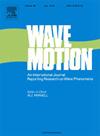油井中的声波传播:半解析和有限元建模方法的比较
IF 2.1
3区 物理与天体物理
Q2 ACOUSTICS
引用次数: 0
摘要
声波测井是检测油井完整性最常用的技术之一。传统的声波技术在分析井固井状况时存在一定的局限性,例如需要拆除生产油管,成本高,耗时长。这增加了人们对多管柱井中水泥质量评估替代解决方案的兴趣。声导波可以用于检测多管柱的水泥状况,最近显示出了很大的前景,主要是通过生产油管进行检测。本文比较了半解析有限元法和有限元法在多层圆柱介质中的波传播模型,模拟油井存在缺陷的情况,以评估油井在多管柱或单管柱情况下的完整性。此外,通过应用二维傅里叶变换,进行了深入的研究,以确定哪种导波模式受水泥套管中常见井下缺陷的存在和严重程度的影响最大。结果表明,半解析有限元方法可以识别出对水泥层缺陷更敏感的导波模式和不传播的导波模式。总的来说,单弦和双弦情况下的频域比较结果一致,表明在5 ~ 25 kHz频率范围内,波形变化最显著的是在慢速低于700μs/m时。与有限元法相比,半解析法计算成本低,模态获取速度快。在单串情况下,半解析法比有限元法快约6.5倍,在最复杂情况下,比有限元法快1.8倍;在双管柱情况下,半解析法最快的求解速度是有限元法的3.5倍左右,最复杂的求解速度是有限元法的1.2倍左右。由此证明,采用半解析有限元法进行油井完整性分析是一种可行的替代方法。本文章由计算机程序翻译,如有差异,请以英文原文为准。
Acoustic wave propagation in oil wells: A comparison between semi-analytical and finite element modeling approaches
Acoustic logging is one of the most used techniques for inspecting the integrity of oil wells. Traditional acoustic techniques have some limitations to analyze the condition of the cement layer of wells, such as the need for removing the production tubing, which is costly and time-consuming. This increased the interest in alternative solutions that allow the assessment of cement quality in multi-string wells. Acoustic-guided waves can be employed to inspect the cement condition in a multi-string scenario, which have recently shown to be promising, mainly regarding inspection through the production tubing. This article compares semi-analytical finite elements method and finite element method to model wave propagation in multilayered cylindrical media, mimicking an oil well under the presence of defects, in order to assess the integrity of oil wells either in the multi or single string well scenarios. In addition, a thorough investigation, through the application of the two-dimensional Fourier transform, was carried out to identify which guided wave mode is most affected by the presence and the severity of common downhole defects in the cement casing. Results show that, the semi-analytical finite element method can be used to identify guided wave modes that are more sensitive to defects in the cement layer and those that do not propagate. In general, the comparisons in the frequency domain for single or dual-string cases had good agreement, showing that the most considerable variation of the wavemodes occurs at slownesses below /m in the frequency range from 5 to 25 kHz. The semi-analytical method had a lower computational cost and faster mode acquisition speed than the finite element method. The semi-analytical method in single-string case was up to approximately 6.5 fold faster than the finite element method and, in the most complex case, it was 1.8 fold faster than the finite element method; whereas the semi-analytical method in dual-string case, the quickest case was approximately 3.5 fold faster than the finite element method and, the most complex case was 1.2 fold faster than the finite element method. Therefore, it was proven that the use of the semi-analytical finite element method is a viable alternative for the analysis of the integrity of oil wells.
求助全文
通过发布文献求助,成功后即可免费获取论文全文。
去求助
来源期刊

Wave Motion
物理-力学
CiteScore
4.10
自引率
8.30%
发文量
118
审稿时长
3 months
期刊介绍:
Wave Motion is devoted to the cross fertilization of ideas, and to stimulating interaction between workers in various research areas in which wave propagation phenomena play a dominant role. The description and analysis of wave propagation phenomena provides a unifying thread connecting diverse areas of engineering and the physical sciences such as acoustics, optics, geophysics, seismology, electromagnetic theory, solid and fluid mechanics.
The journal publishes papers on analytical, numerical and experimental methods. Papers that address fundamentally new topics in wave phenomena or develop wave propagation methods for solving direct and inverse problems are of interest to the journal.
 求助内容:
求助内容: 应助结果提醒方式:
应助结果提醒方式:


